Accounting for Managers (ACC00724) Assignment Solution
VerifiedAdded on 2022/11/07
|9
|914
|479
Homework Assignment
AI Summary
This assignment solution for Accounting for Managers (ACC00724) analyzes financial statements, covering profitability, liquidity, and efficiency ratios. It includes calculations for gross margin, net profit, debt-to-assets, account receivables, and interest coverage. The solution also addresses break-even analysis, calculating break-even points in units and dollars, and explores the impact of revised fixed costs and selling prices. Furthermore, the assignment delves into overhead allocation, differentiating between machine hours and direct labor cost, and detailing the process of calculating overhead recovery rates for different departments. The document uses examples to illustrate concepts and includes references to relevant accounting literature.

Accounting for Managers
Paraphrase This Document
Need a fresh take? Get an instant paraphrase of this document with our AI Paraphraser
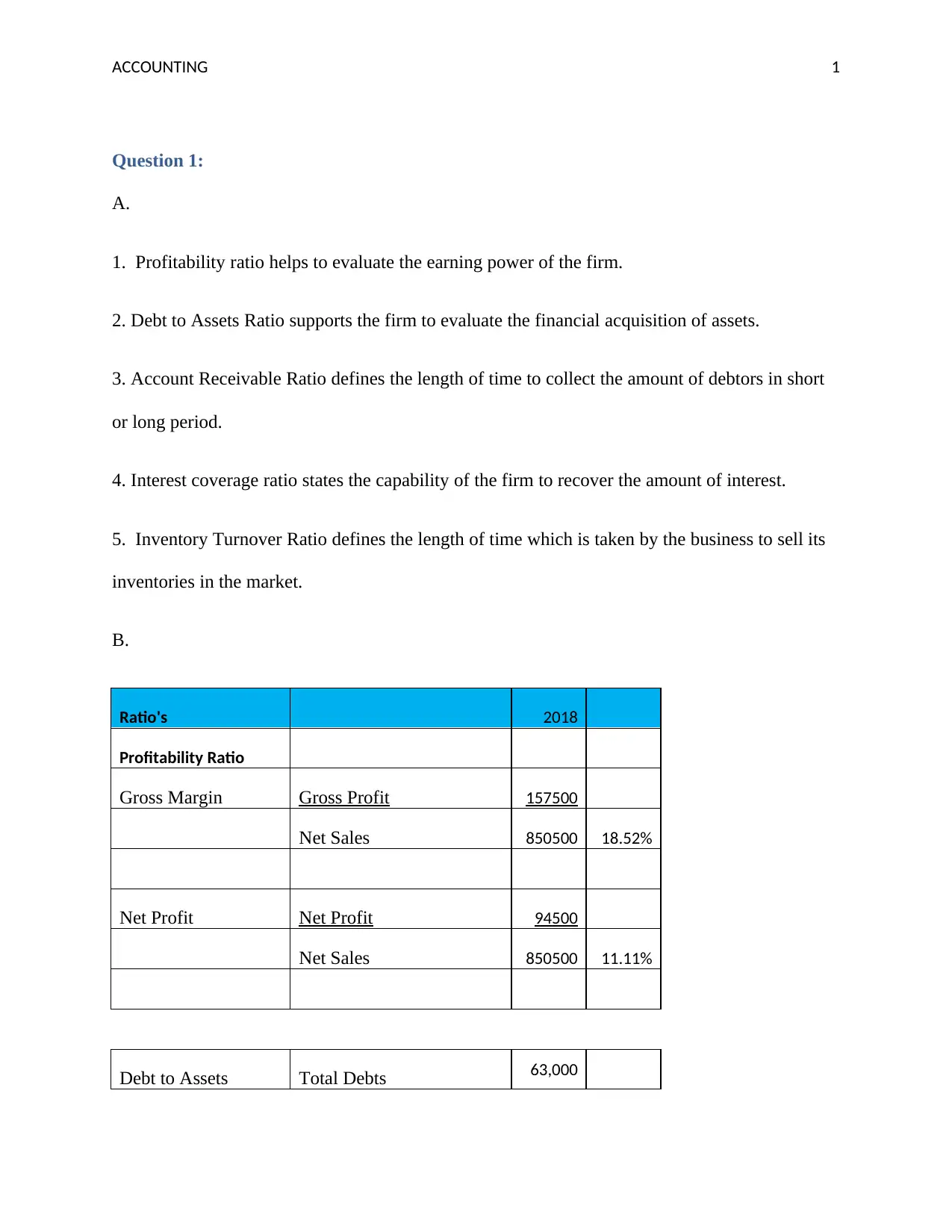
ACCOUNTING 1
Question 1:
A.
1. Profitability ratio helps to evaluate the earning power of the firm.
2. Debt to Assets Ratio supports the firm to evaluate the financial acquisition of assets.
3. Account Receivable Ratio defines the length of time to collect the amount of debtors in short
or long period.
4. Interest coverage ratio states the capability of the firm to recover the amount of interest.
5. Inventory Turnover Ratio defines the length of time which is taken by the business to sell its
inventories in the market.
B.
Ratio's 2018
Profitability Ratio
Gross Margin Gross Profit 157500
Net Sales 850500 18.52%
Net Profit Net Profit 94500
Net Sales 850500 11.11%
Debt to Assets Total Debts 63,000
Question 1:
A.
1. Profitability ratio helps to evaluate the earning power of the firm.
2. Debt to Assets Ratio supports the firm to evaluate the financial acquisition of assets.
3. Account Receivable Ratio defines the length of time to collect the amount of debtors in short
or long period.
4. Interest coverage ratio states the capability of the firm to recover the amount of interest.
5. Inventory Turnover Ratio defines the length of time which is taken by the business to sell its
inventories in the market.
B.
Ratio's 2018
Profitability Ratio
Gross Margin Gross Profit 157500
Net Sales 850500 18.52%
Net Profit Net Profit 94500
Net Sales 850500 11.11%
Debt to Assets Total Debts 63,000
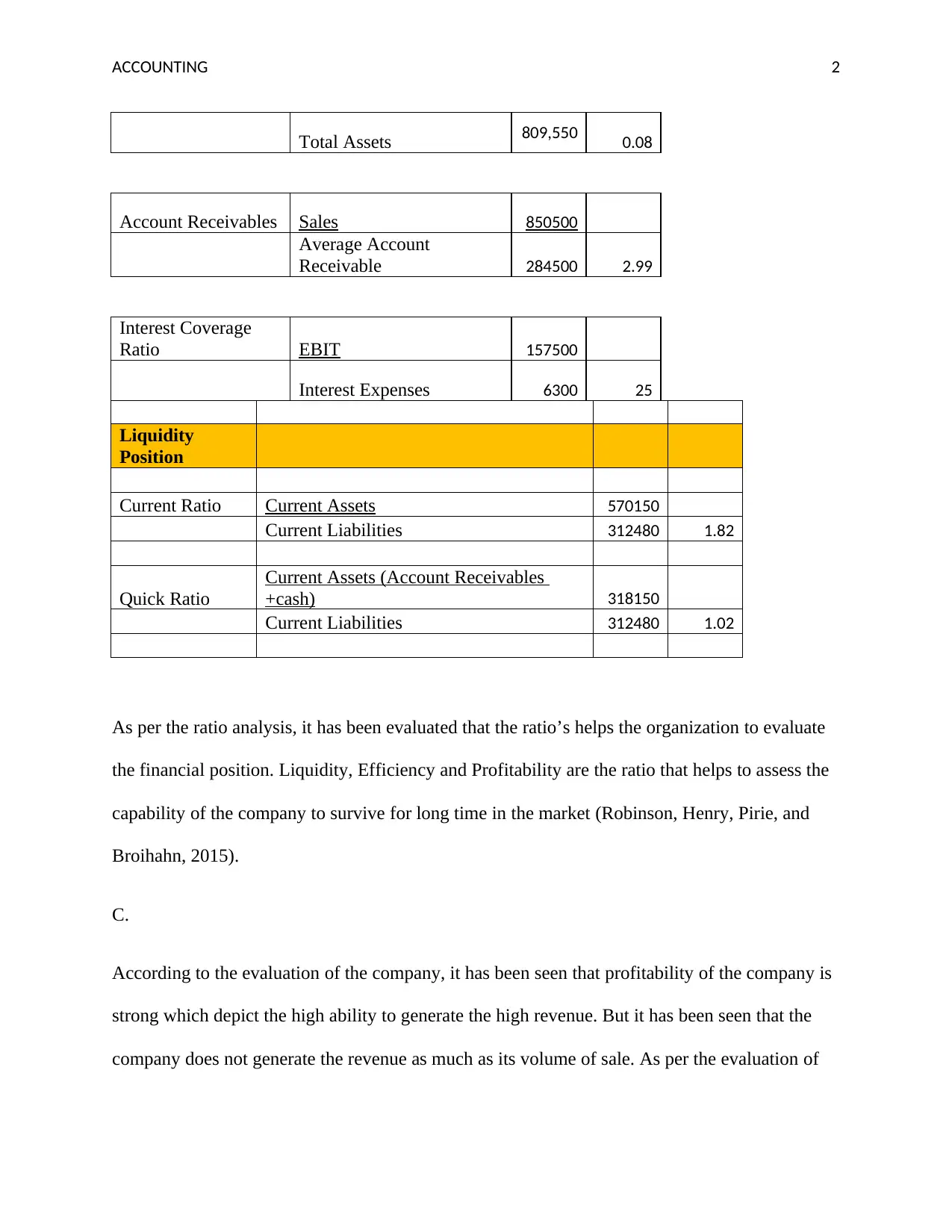
ACCOUNTING 2
Total Assets 809,550 0.08
Account Receivables Sales 850500
Average Account
Receivable 284500 2.99
Interest Coverage
Ratio EBIT 157500
Interest Expenses 6300 25
Liquidity
Position
Current Ratio Current Assets 570150
Current Liabilities 312480 1.82
Quick Ratio
Current Assets (Account Receivables
+cash) 318150
Current Liabilities 312480 1.02
As per the ratio analysis, it has been evaluated that the ratio’s helps the organization to evaluate
the financial position. Liquidity, Efficiency and Profitability are the ratio that helps to assess the
capability of the company to survive for long time in the market (Robinson, Henry, Pirie, and
Broihahn, 2015).
C.
According to the evaluation of the company, it has been seen that profitability of the company is
strong which depict the high ability to generate the high revenue. But it has been seen that the
company does not generate the revenue as much as its volume of sale. As per the evaluation of
Total Assets 809,550 0.08
Account Receivables Sales 850500
Average Account
Receivable 284500 2.99
Interest Coverage
Ratio EBIT 157500
Interest Expenses 6300 25
Liquidity
Position
Current Ratio Current Assets 570150
Current Liabilities 312480 1.82
Quick Ratio
Current Assets (Account Receivables
+cash) 318150
Current Liabilities 312480 1.02
As per the ratio analysis, it has been evaluated that the ratio’s helps the organization to evaluate
the financial position. Liquidity, Efficiency and Profitability are the ratio that helps to assess the
capability of the company to survive for long time in the market (Robinson, Henry, Pirie, and
Broihahn, 2015).
C.
According to the evaluation of the company, it has been seen that profitability of the company is
strong which depict the high ability to generate the high revenue. But it has been seen that the
company does not generate the revenue as much as its volume of sale. As per the evaluation of
⊘ This is a preview!⊘
Do you want full access?
Subscribe today to unlock all pages.

Trusted by 1+ million students worldwide
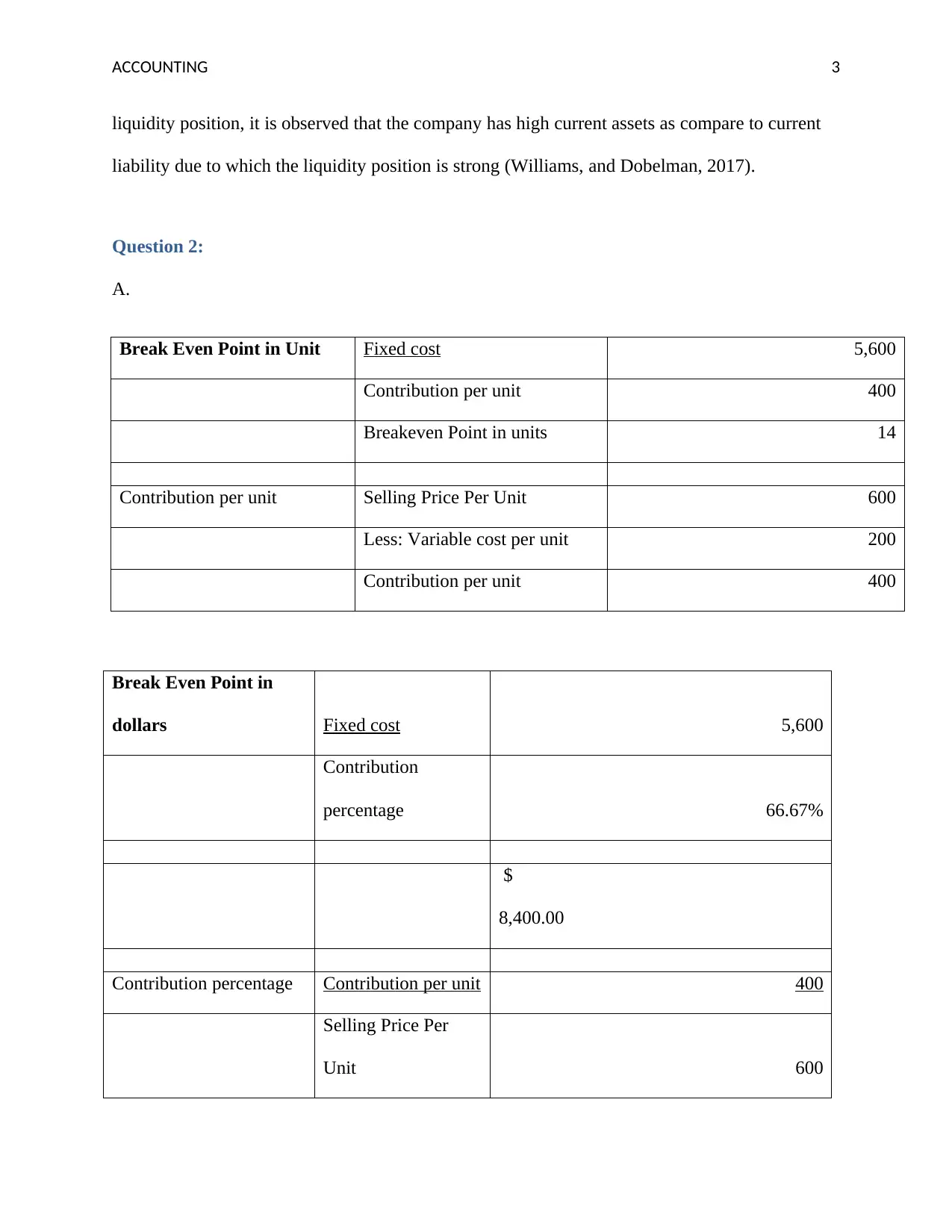
ACCOUNTING 3
liquidity position, it is observed that the company has high current assets as compare to current
liability due to which the liquidity position is strong (Williams, and Dobelman, 2017).
Question 2:
A.
Break Even Point in Unit Fixed cost 5,600
Contribution per unit 400
Breakeven Point in units 14
Contribution per unit Selling Price Per Unit 600
Less: Variable cost per unit 200
Contribution per unit 400
Break Even Point in
dollars Fixed cost 5,600
Contribution
percentage 66.67%
$
8,400.00
Contribution percentage Contribution per unit 400
Selling Price Per
Unit 600
liquidity position, it is observed that the company has high current assets as compare to current
liability due to which the liquidity position is strong (Williams, and Dobelman, 2017).
Question 2:
A.
Break Even Point in Unit Fixed cost 5,600
Contribution per unit 400
Breakeven Point in units 14
Contribution per unit Selling Price Per Unit 600
Less: Variable cost per unit 200
Contribution per unit 400
Break Even Point in
dollars Fixed cost 5,600
Contribution
percentage 66.67%
$
8,400.00
Contribution percentage Contribution per unit 400
Selling Price Per
Unit 600
Paraphrase This Document
Need a fresh take? Get an instant paraphrase of this document with our AI Paraphraser
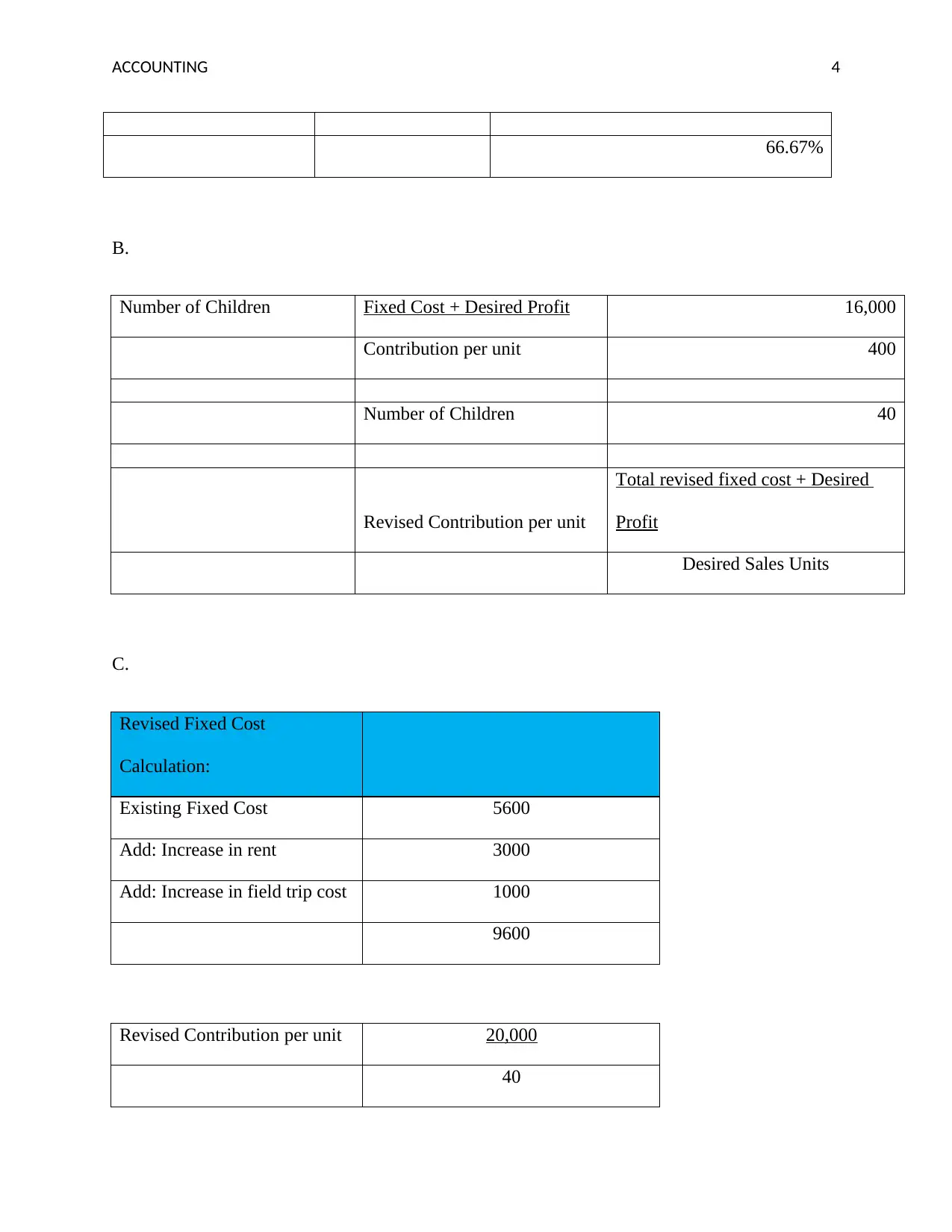
ACCOUNTING 4
66.67%
B.
Number of Children Fixed Cost + Desired Profit 16,000
Contribution per unit 400
Number of Children 40
Revised Contribution per unit
Total revised fixed cost + Desired
Profit
Desired Sales Units
C.
Revised Fixed Cost
Calculation:
Existing Fixed Cost 5600
Add: Increase in rent 3000
Add: Increase in field trip cost 1000
9600
Revised Contribution per unit 20,000
40
66.67%
B.
Number of Children Fixed Cost + Desired Profit 16,000
Contribution per unit 400
Number of Children 40
Revised Contribution per unit
Total revised fixed cost + Desired
Profit
Desired Sales Units
C.
Revised Fixed Cost
Calculation:
Existing Fixed Cost 5600
Add: Increase in rent 3000
Add: Increase in field trip cost 1000
9600
Revised Contribution per unit 20,000
40
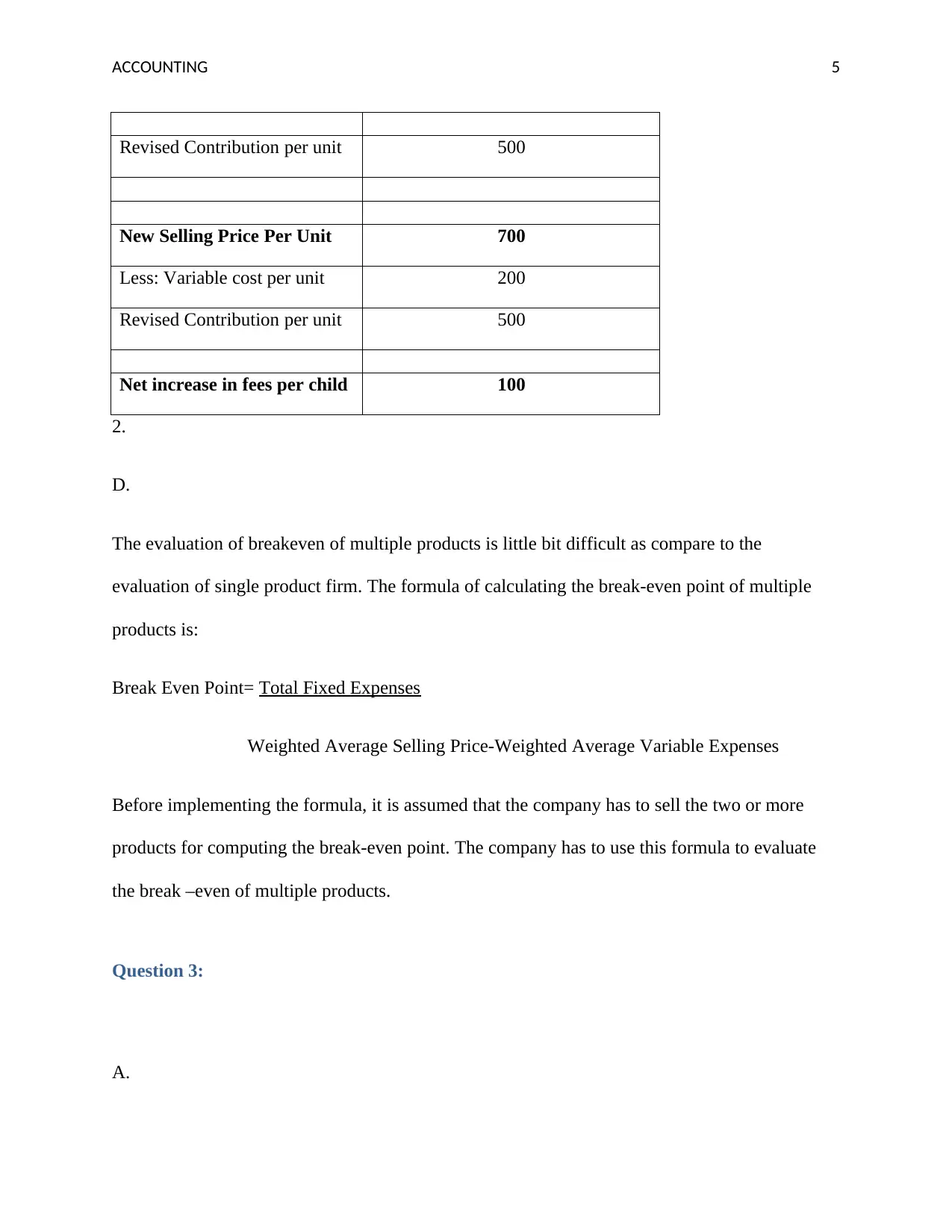
ACCOUNTING 5
Revised Contribution per unit 500
New Selling Price Per Unit 700
Less: Variable cost per unit 200
Revised Contribution per unit 500
Net increase in fees per child 100
2.
D.
The evaluation of breakeven of multiple products is little bit difficult as compare to the
evaluation of single product firm. The formula of calculating the break-even point of multiple
products is:
Break Even Point= Total Fixed Expenses
Weighted Average Selling Price-Weighted Average Variable Expenses
Before implementing the formula, it is assumed that the company has to sell the two or more
products for computing the break-even point. The company has to use this formula to evaluate
the break –even of multiple products.
Question 3:
A.
Revised Contribution per unit 500
New Selling Price Per Unit 700
Less: Variable cost per unit 200
Revised Contribution per unit 500
Net increase in fees per child 100
2.
D.
The evaluation of breakeven of multiple products is little bit difficult as compare to the
evaluation of single product firm. The formula of calculating the break-even point of multiple
products is:
Break Even Point= Total Fixed Expenses
Weighted Average Selling Price-Weighted Average Variable Expenses
Before implementing the formula, it is assumed that the company has to sell the two or more
products for computing the break-even point. The company has to use this formula to evaluate
the break –even of multiple products.
Question 3:
A.
⊘ This is a preview!⊘
Do you want full access?
Subscribe today to unlock all pages.

Trusted by 1+ million students worldwide
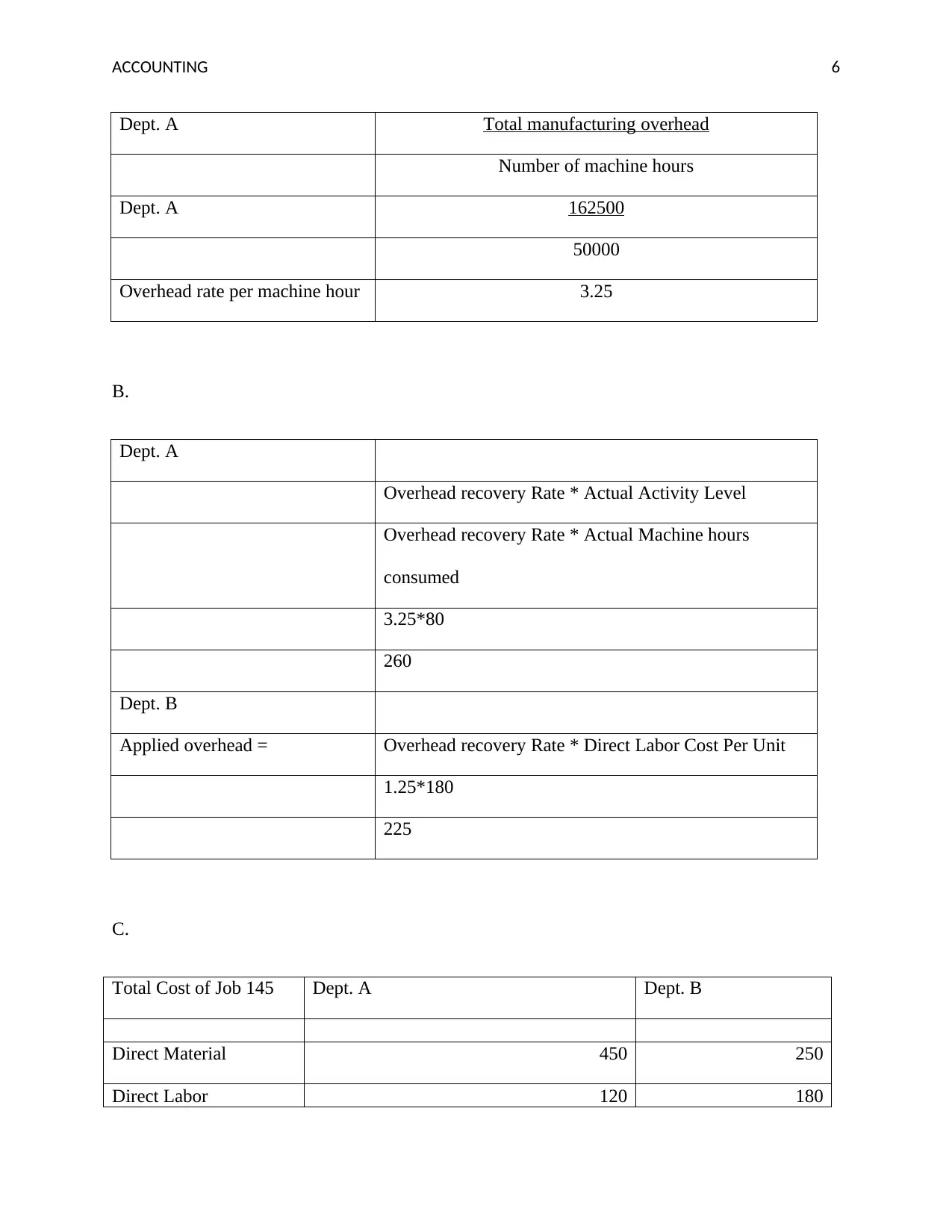
ACCOUNTING 6
Dept. A Total manufacturing overhead
Number of machine hours
Dept. A 162500
50000
Overhead rate per machine hour 3.25
B.
Dept. A
Overhead recovery Rate * Actual Activity Level
Overhead recovery Rate * Actual Machine hours
consumed
3.25*80
260
Dept. B
Applied overhead = Overhead recovery Rate * Direct Labor Cost Per Unit
1.25*180
225
C.
Total Cost of Job 145 Dept. A Dept. B
Direct Material 450 250
Direct Labor 120 180
Dept. A Total manufacturing overhead
Number of machine hours
Dept. A 162500
50000
Overhead rate per machine hour 3.25
B.
Dept. A
Overhead recovery Rate * Actual Activity Level
Overhead recovery Rate * Actual Machine hours
consumed
3.25*80
260
Dept. B
Applied overhead = Overhead recovery Rate * Direct Labor Cost Per Unit
1.25*180
225
C.
Total Cost of Job 145 Dept. A Dept. B
Direct Material 450 250
Direct Labor 120 180
Paraphrase This Document
Need a fresh take? Get an instant paraphrase of this document with our AI Paraphraser
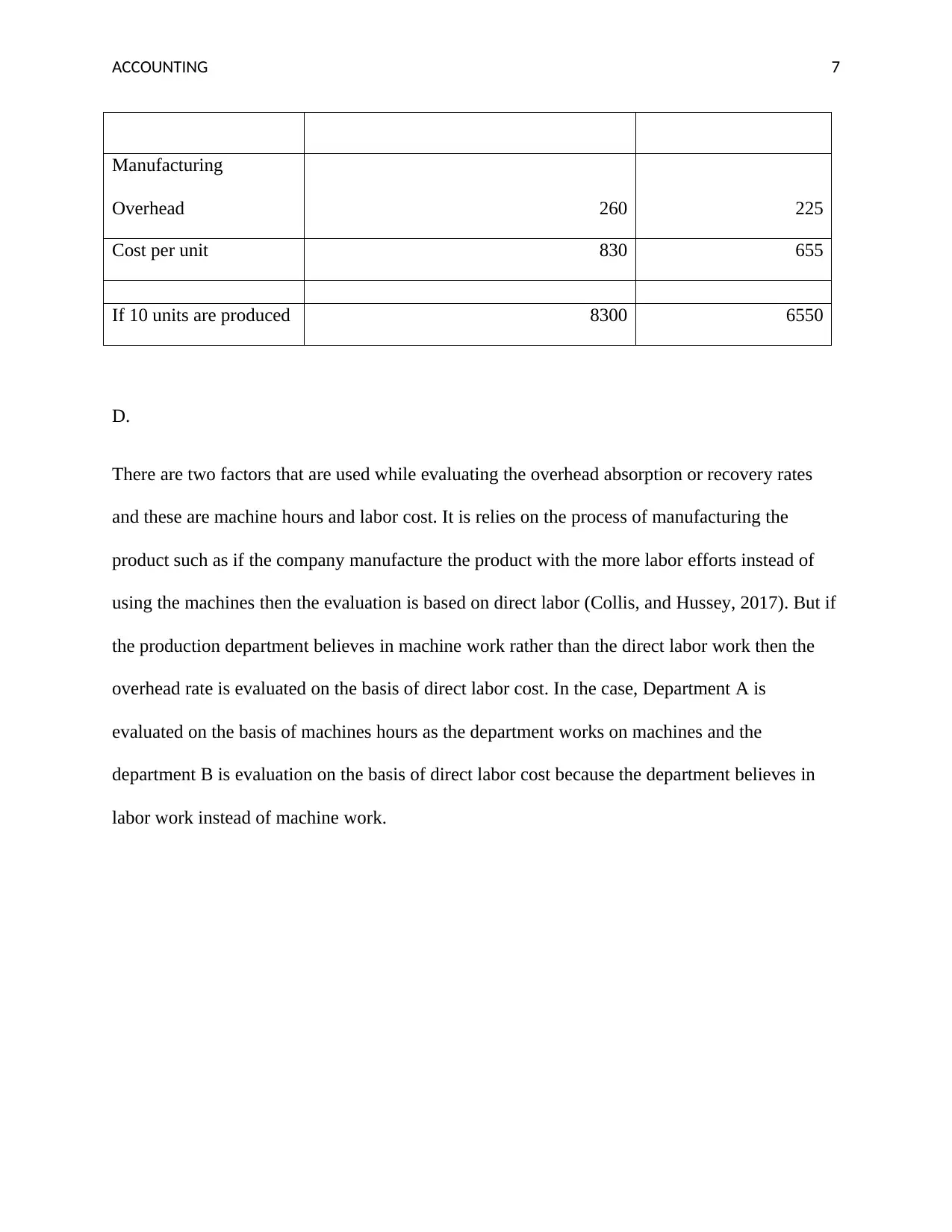
ACCOUNTING 7
Manufacturing
Overhead 260 225
Cost per unit 830 655
If 10 units are produced 8300 6550
D.
There are two factors that are used while evaluating the overhead absorption or recovery rates
and these are machine hours and labor cost. It is relies on the process of manufacturing the
product such as if the company manufacture the product with the more labor efforts instead of
using the machines then the evaluation is based on direct labor (Collis, and Hussey, 2017). But if
the production department believes in machine work rather than the direct labor work then the
overhead rate is evaluated on the basis of direct labor cost. In the case, Department A is
evaluated on the basis of machines hours as the department works on machines and the
department B is evaluation on the basis of direct labor cost because the department believes in
labor work instead of machine work.
Manufacturing
Overhead 260 225
Cost per unit 830 655
If 10 units are produced 8300 6550
D.
There are two factors that are used while evaluating the overhead absorption or recovery rates
and these are machine hours and labor cost. It is relies on the process of manufacturing the
product such as if the company manufacture the product with the more labor efforts instead of
using the machines then the evaluation is based on direct labor (Collis, and Hussey, 2017). But if
the production department believes in machine work rather than the direct labor work then the
overhead rate is evaluated on the basis of direct labor cost. In the case, Department A is
evaluated on the basis of machines hours as the department works on machines and the
department B is evaluation on the basis of direct labor cost because the department believes in
labor work instead of machine work.
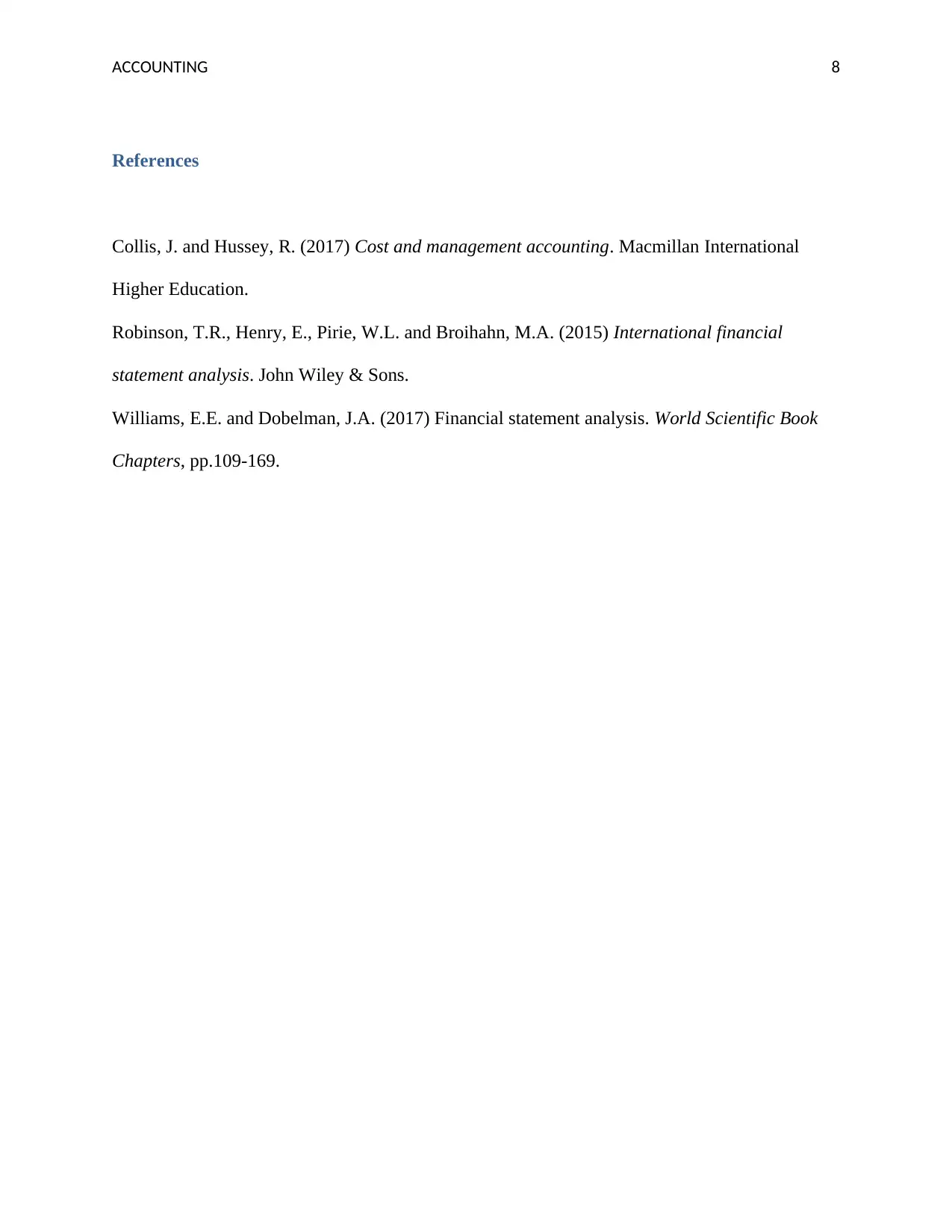
ACCOUNTING 8
References
Collis, J. and Hussey, R. (2017) Cost and management accounting. Macmillan International
Higher Education.
Robinson, T.R., Henry, E., Pirie, W.L. and Broihahn, M.A. (2015) International financial
statement analysis. John Wiley & Sons.
Williams, E.E. and Dobelman, J.A. (2017) Financial statement analysis. World Scientific Book
Chapters, pp.109-169.
References
Collis, J. and Hussey, R. (2017) Cost and management accounting. Macmillan International
Higher Education.
Robinson, T.R., Henry, E., Pirie, W.L. and Broihahn, M.A. (2015) International financial
statement analysis. John Wiley & Sons.
Williams, E.E. and Dobelman, J.A. (2017) Financial statement analysis. World Scientific Book
Chapters, pp.109-169.
⊘ This is a preview!⊘
Do you want full access?
Subscribe today to unlock all pages.

Trusted by 1+ million students worldwide
1 out of 9
Related Documents
Your All-in-One AI-Powered Toolkit for Academic Success.
+13062052269
info@desklib.com
Available 24*7 on WhatsApp / Email
![[object Object]](/_next/static/media/star-bottom.7253800d.svg)
Unlock your academic potential
Copyright © 2020–2025 A2Z Services. All Rights Reserved. Developed and managed by ZUCOL.





